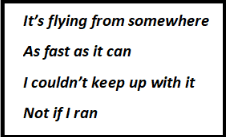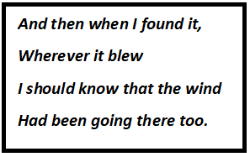Class 3 Exam > Class 3 Notes > Class 3 English Alive > Textbook Solutions: Wind on the Hill
Textbook Solutions: Wind on the Hill | Class 3 English Alive PDF Download
Word Galaxy
Ans:
- Experience – event or situation that affects someone
- Blow – movement of wind
- Grappling – struggling
- Future – time that will come when the present time passes
- Keep up – to try to be in the same position or condition as someone
COMPREHENSION
A. Choose the correct option
1.
Ans: (ii) nobody
2.
Ans: (i) never catch up with the wind
3.
Ans: (iii) a day and a night
4.
Ans: (iii) where the wind comes from
B. Read the lines from the poem and answer the questions.
1. 
(a).
Ans: ‘It’ is the wind.
(b).
Ans: ‘I’ refers to the poet AA Milne.
2.

(a).
Ans: ‘It’ refers to the kite.
(b).
Ans: The poet should know that the wind had been going to the place where the kite flew to.
(c) Find rhyming words from the poem for the following words.
Ans:
- Blew- too
- Can- ran
- Kite- night
- Knows- goes
VOCABULARY
Use the words in brackets to complete the similes. One has been done for you.
Ans:
- Jia runs as fast as (fast) a deer.
- Ravi is gentle like (gentle) a lamb.
- Hena is as brave as (brave) a lion.
- Grandpa is as wise as (wise) an owl.
- Leena is timid like (timid) a rabbit.
- Gurjit is as playful as a kitten.
- The sheet was as white as (white) snow.
- Zeba's hair is black like (black) charcoal.
The document Textbook Solutions: Wind on the Hill | Class 3 English Alive is a part of the Class 3 Course Class 3 English Alive.
All you need of Class 3 at this link: Class 3
|
14 videos|17 docs|14 tests
|
FAQs on Textbook Solutions: Wind on the Hill - Class 3 English Alive
| 1. What is the significance of wind in the poem "Wind on the Hill"? |  |
Ans. The wind in the poem represents freedom, movement, and the power of nature. It is described as a playful and joyful force that brings life to the hill.
| 2. How does the poet describe the sound of the wind in the poem? |  |
Ans. The poet describes the sound of the wind as a song that echoes through the hill and fills the air with a sense of joy and playfulness.
| 3. What emotions does the wind evoke in the poet? |  |
Ans. The wind evokes feelings of happiness, freedom, and a connection to nature in the poet. It brings a sense of wonder and awe to the surroundings.
| 4. How does the wind interact with the natural environment in the poem? |  |
Ans. The wind is portrayed as dancing through the trees, playing with the grass, and creating ripples on the water. It interacts with the environment in a lively and dynamic way.
| 5. What is the overall message of the poem "Wind on the Hill"? |  |
Ans. The poem conveys a message of embracing the beauty and power of nature, finding joy in the simple things in life, and being present in the moment to appreciate the wonders of the world around us.

|
Explore Courses for Class 3 exam
|

|
Signup for Free!
Signup to see your scores go up within 7 days! Learn & Practice with 1000+ FREE Notes, Videos & Tests.
Related Searches

















